Optimising human resources to propel economic development
15 April 2018
Talent is the most valuable asset to Hong Kong, as well as the anchor and engine for our socio-economic growth. It also plays a key role in the current-term SAR Government’s endeavours to promote a high value-added diversified economy, explore new economic spheres, and harness the opportunities arising from the national Belt and Road Initiative and the Guangdong-Hong Kong-Macao Bay Area development.
To meet our short, medium and long-term development needs, it is incumbent on us to set a clear direction in manpower planning so that the resources and efforts of the Government and various sectors can be consolidated for the purposes of taking forward the manpower policies in a holistic manner and keeping Hong Kong competitive in the long run. Such are the work objectives of the Human Resources Planning Commission chaired by me, the first meeting of which was held last week (on 9 April).
In 2015, the Government announced an overall population policy to provide a direction for enhancing the local workforce in terms of both quality and quantity at the macro level in response to an ageing population and an anticipated shrinkage in workforce. We, as a matter of fact, have been facing a tight labour market for quite some time. The latest unemployment rate of 2.9%, which basically represents “full employment”, is a historical low (dipping below 3% for the first time in 20 years).
To optimise the local labour force, unleashing its potential is one of the core strategies for human resources planning. In this regard, we encourage mature persons (aged between 50 and 64) and the “young old” (aged between 65 and 74) who are healthy and wish to continue working to re-enter the job market. Government policies are also in place to create an enabling environment for elderly employment. A clearly successful example is the measure of raising the upper age limit for Category B Security Personnel Permit from 65 to 70 in late 2015. Since then, more than 14 000 applications for permits with validity going beyond the age of 65 have been approved.
Another initiative taken by us is extending the service of new government recruits. The retirement age of new recruits appointed to the civil service on or after 1 June 2015 has been raised to 65 for civilian grades, and 60 for all ranks of disciplined services grades. Over 23 000 new appointments have been made on these terms so far. Regarding serving civil servants, we have decided to allow those joining the Government between 1 June 2000 and 31 May 2015 to choose to retire at 65 (for civilian grades) or 60 (for disciplined services grades). We are conducting consultation on the proposed implementation framework in the hope of implementing the measure soon. Furthermore, a package of initiatives have been introduced to allow bureaux and departments flexibility in retaining experienced serving officers reaching retirement age to meet their manpower and operational needs.
Our efforts in promoting a longer working life and other policy initiatives have paid off. The labour force participation rate of elderly persons in Hong Kong has increased markedly over the past decade. The participation rate of persons aged 65 or above has risen from 5.2% in 2007 to 11% in 2017, with a particularly notable increase in the “young old” group from 8.3% to 17.7%. However, we are still way behind some Asian neighbours. The corresponding figures for Japan, Singapore and South Korea are 22.7%, 26.8% and 31.5% respectively.

|
To further encourage local employers to hire mature persons, the Labour Department will enhance the Employment Programme for the Middle-aged in 2018. Employers engaging mature job seekers aged 60 or above who have left the workforce or are unemployed and providing them with on-the-job training will be granted an on-the-job training allowance of up to $4,000 per month for a period of 6 to 12 months.
Women are also a source of labour supply that should not be overlooked. It is never easy for parents in Hong Kong to strike a balance between career and family duties under a demanding and competitive work environment. Changes in family structure, financial conditions and personal plans may prompt women of different education and socio-economic backgrounds to join or leave the workforce at different stages. Our female labour force participation rate, though increasing slightly from 49.7% in 2007 to 50.9% in 2017, is far below the men’s rate of 68.3%. The Government will continue to strengthen the training and employment support for women to encourage more of them to join the labour market.

|
The Employees Retraining Board offers a series of courses suitable for women whose family commitments may not allow for full-time training. In particular, under its Modular Certificates Accumulation Scheme, a trainee may be awarded a certificate for a qualification equivalent to a full-time course upon completion of some specified half-day or evening courses. So women who are unable to take full-time courses can study according to their own schedules and acquire recognised qualifications with the flexibility given. The scheme currently covers courses for post-natal care workers, care workers, and infant and child care workers, providing more training options for women hoping to rejoin the workforce.
To give mothers the choice to join the workforce, the Government is taking various measures to strengthen child care services in order to alleviate the pressure on working parents struggling with child care duties. The support for family is provided on many fronts. For example, we offer subvention to non-governmental organisations to run a variety of child care services for children aged below six, and grant fee exemption or remission to needy families. As announced in the Chief Executive’s Policy Address last October, about 300 additional places in aided stand-alone child care centres in North District, Kwun Tong, Kwai Tsing and Sha Tin will be provided starting from 2018-19. As for the long-term development of child care services, we have commissioned the University of Hong Kong to conduct a consultancy study which is expected to be completed in 2018.
A number of related relief measures have also been rolled out. For example, to strengthen support for low-income families, the household income limit has been relaxed and 2 000 additional fee-waiving places have been offered under the Fee-waiving Subsidy Scheme under the After-school Care Programme as a pilot initiative subsidised by the Community Care Fund. Of the $400 million injection to the Partnership Fund for the Disadvantaged, $200 million is dedicated to after-school learning and support programmes to benefit about 130 000 children from grassroots families, which in turn can help more women return to the job market.

|
Ethnic minorities are another important component of our human capital. As Hong Kong’s largest employer, the Government always gives them as much help as possible in employment. For example, following the reviews of the Chinese language proficiency requirements for government jobs co-ordinated by the Civil Service Bureau, 53 grades in various departments have lowered the requirements since 2010. In addition, a newly established steering committee chaired by me will co-ordinate, review and monitor at a high level the provision of support for ethnic minorities. A sum of $500 million has been earmarked in the Budget for the purpose.
Nurturing talent, unleashing the local workforce on all fronts and drawing in quality manpower to fill labour gaps are most crucial to Hong Kong’s sustained development. If we are to maintain the city’s soft power and competitive edge, our population policy must be aimed at enhancing both the quality and quantity of our human resources and providing a comprehensive blueprint for manpower planning tailored to the future development needs of Hong Kong. I look forward to working with the Human Resources Planning Commission. We will do our best to map out a targeted and practicable human resources strategy that can give new impetus to this Asia’s world city and help it scale new heights.

